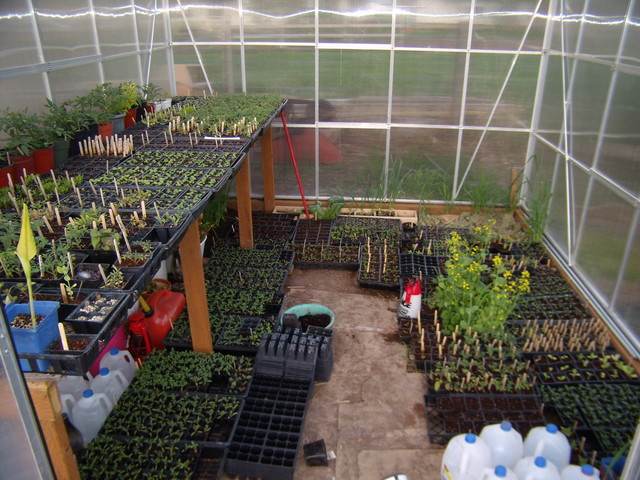
 1
1




"You just keep thinking Butch, that's what you're good at" - Sundance Kid

 2
2








 1
1




"A nation that destroys its soils destroys itself." FDR
"We can't solve problems by using the same kind of thinking we used when we created them.” Einstein




"You just keep thinking Butch, that's what you're good at" - Sundance Kid
 1
1




Thomas Vincent wrote:Thanks for the replies. I'm still a little fogged here. Let me restate the question:
I have a standard cattle panel hoop house measuring 6 feet by 15 feet. (90 sq ft) Winter and summer, on sunny days the interior temperature is a full thirty degrees warmer than outside. If I add four fifty gallon drums of water, (200 gallons) to the interior will that mass affect the interior temperature of the hoop house when the sun shines. And if so, how?
In other words, if I simply add thermal mass to the interior of a green house can I expect to see any difference in the temperature differential between Outside and inside on sunny days?
Thanks.
"People may doubt what you say, but they will believe what you do."




"You just keep thinking Butch, that's what you're good at" - Sundance Kid




Thomas Vincent wrote:Todd,
Thanks, that was very helpful.
One geeky question and then I'm done. When the barrels of water absorb heat on sunny days, is it only radiant heat from the sun - heat that would otherwise add to the temperature of the space - or are the barrels only absorbing heat from the room itself? (By convection?)
Thanks to everyone.
"People may doubt what you say, but they will believe what you do."
 1
1




Thomas Vincent wrote: When the barrels of water absorb heat on sunny days, is it only radiant heat from the sun - heat that would otherwise add to the temperature of the space - or are the barrels only absorbing heat from the room itself? (By convection?)
I make a Maple Syrup instructional movie! Check it out HERE
SKIP books, get 'em while they're hot!!! Skills to Inherit Property
See me in a movie building a massive wood staircase:Low Tech Lab Movie













 Note though that the air at the top of an unventilated greenhouse and well above the significant mass will get hotter (by convection), but your plants are likely in the lower and cooler zone.
Note though that the air at the top of an unventilated greenhouse and well above the significant mass will get hotter (by convection), but your plants are likely in the lower and cooler zone.

 1
1





 2
2




"You just keep thinking Butch, that's what you're good at" - Sundance Kid
 2
2




 3
3







 1
1




Together is our favorite place to be
 4
4




 1
1




 2
2












bob day wrote:Great Links Tom, very informative. I've been puzzling over how to grow figs and actually get a good crop, looks like the fruit walls are the solution. I had no idea they were so effective, or had such a long history
 2
2




David Maxwell wrote:... The pumps to pump the water through the radiators (my "heat exchangers") are controlled by a differential thermostat, so that they run only when the temperature of the air, (in the peak), is higher than the temperature of the water. It was apparent that the heat was coming out of the water in the tanks reasonably efficiently, as the temp in the tanks drops as much as 20 degrees C overnight. But I have gilded this lily a little - I am pumping the water through black plastic piles buried 8" down in the growing beds, 24 hours a day, (at least when the cheap pumps are still working). I did this on the principle that heating the plants' toes made more sense that trying to heat the entire volume of air in the greenhouse. But it had an unexpected effect - it added the soil in the growing beds to the thermal mass. The temperature in the tank with a functioning soil pump runs about 2 degrees lower than the other one, and the soil temperature in the the "circulated" beds, runs 2 degrees higher than the ones without circulating water. In addition to the pumps, I have 4 large computer fans which draw the air from the peak through the radiators. All these pumps, fans and controllers run off a 90 Watt P-V panel with a small battery storage (actually the battery from my ride-on mower) which carries the soil pumps through the night. Obviously, since I am able to quote these temperatures, I also have a monitoring system capable of storing a log of data drawn from, (in my case), 4 separate channels.. (Mine currently polls the temp sensors every 10 minutes).
David Maxwell wrote: Does movable thermal curtain insulation count as "active"? (That is my next "refinement", after I get, and install, some new pumps, which hopefully will last a little longer.)




EBo --
Master Gardener (Prince George's County, MD, USA)

|
And then the flying monkeys attacked. My only defense was this tiny ad:
The new kickstarter is now live!
https://www.kickstarter.com/projects/paulwheaton/garden-cards
|







